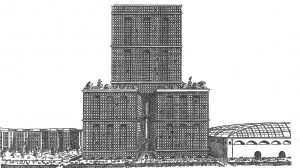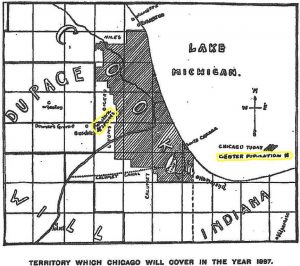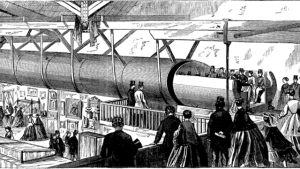In 1897, the Chicago Tribune ran a story entitled “Chicago As It Will Be 100 Years from Now, a City of Wonders Unbelievable.” And, Western Springs was to be at the center of it all.
In 1897, exactly one hundred and fifteen years ago, Chicago was anything but modern. While the 1893 World’s Columbian Exposition had dazzled visitors from all over the country, the rest of the city was still dusty, dirty, and dangerous. For example, the polluted Chicago River still flowed into Lake Michigan, there were only a handful of buildings over ten stories tall, and most everything still moved by horse-drawn means. The airplane would not even be invented for seven more years. Electric streetcars were just beginning to appear, as was electricity in general. But, the city was growing at an amazing rate, reaching 1.6 million by 1900.
Amid this growth and change, the Chicago Tribune ran a full-page story that predicted how the city and surrounding area might appear in one hundred years, i.e., in 1997. And, many of the predictions were “spot on”. For example:
Future Buildings
The story predicted that “Buildings of the present (1897) will have vanished to make room for stupendous structures.” The article described buildings of 60 or 70 stories in height. See the first photo. To see how remarkable this prediction was, one only has to recall that, as recent as 1955, the city’s tallest structure was the 41-story Prudential Building.

Projected 70-Story Building
The article also described the only limiting factor being elevators, which, in the future, would be powered by electricity. It predicted that “… the elevator of the future will be entirely unlike what we call an elevator. Electricity will change all that. The time will probably come when tenants of a building and their patrons will be carried up by means of perpetually ascending platforms.”
In vast buildings of this sort, the article forecast that “… upper floors will be devoted to offices, theaters, restaurants, and the great roofs might well be given up to roof gardens, where trees and shrubbery might grow.” Indoor stadiums would also be built capable of accommodating 125,000 spectators. The article also discussed the cost of such buildings, stating that “billions (of dollars) will be in use then as millions are now.”
Population Growth
At the end of the 20th century (1997), the urban area was predicted to cover 1,000 square miles. In fact, today’s Chicagoland urban area is estimated at 2,100 square miles. And, according to the 1897 experts, “Population will approach 10 million people (in 1997) and will cover all of Cook and DuPage counties, as well as the northern portion of Will County. Well, that prediction was surprisingly close: today’s Chicago urban area has more than 8.7 million residents.
Of special interest, the article went on to say that the center of the population will “probably (be) Western Springs, now just east of the DuPage County line.” In 1897, our village’s population was just 600 or so, and the town was surrounded by farmland. So, imagine how wild this prediction must have sounded to our residents!
Lifestyle Changes

Projected Population in 1997
The article also described how “… the manufacturing interests of the city will have moved south into Will County and northern Indiana.” The story also predicted that cemeteries would be converted into parks as the practice of cremation, then frowned upon, would become generally accepted.
The city of 1997 was to be clean: “Smoke will disappear, for the consumption of coal will be too costly. Electricity will furnish heat, light, and power, creating a cleaner and healthier lifestyle.” The article also envisioned a time when “fruits and vegetables will know practically no season, for they will be transported from every corner of the country within the forty-five hours that they appear on the stands.”
It was predicted that “ … Chicago’s drainage canal would become inadequate and would be “… superseded by great tunnels that will collect the sewage and move it to points north, south, and west, where the material will be distributed to farms many miles away.”
The interior of homes was expected to be less crowded. According to the article, “There will be more light and more air. Wooden buildings will disappear and the people will decentralize themselves.” It was predicted that citizens would be of “… sturdier build and better brain, for correct sanitation and plenty of fresh air, will build up their bodies.”
Future Transportation
The article foresaw a time when the omnipresent horses of that era would disappear (except at race tracks) and would be replaced by electric vehicles.
 While the article never mentioned the possibility of air travel, there was the subject of “pneumatic tubes”, similar to what you see at the bank’s drive-up. But, these would be six or more feet in diameter and capable of accommodating passengers. According to the story, “Suburban (train) service will be entirely conducted by means of pneumatic tubes, which will whisk passengers from a suburb ten miles away to the heart of the town in less than five minutes.”
While the article never mentioned the possibility of air travel, there was the subject of “pneumatic tubes”, similar to what you see at the bank’s drive-up. But, these would be six or more feet in diameter and capable of accommodating passengers. According to the story, “Suburban (train) service will be entirely conducted by means of pneumatic tubes, which will whisk passengers from a suburb ten miles away to the heart of the town in less than five minutes.”
As for more distant travel, the article suggested that, “… communication with distant points east and west will be carried on by means of the pneumatic tube service. It will take but an hour to reach New York.” Although this may seem farfetched today, Jules Verne had proposed the same concept in 1863 and a working prototype (just 100 hundred feet long) was demonstrated in 1867 at the American Institute Exhibition. See the third photo.
The article also speculated that “… short distance local traffic will be secured by means of the traveling sidewalk placed below the boulevards. There will be no charge, the municipality maintaining this feature of travel.”
Government
Lastly, the forecasters predicted the formation of “… the separate and independent State of Chicago. The time must come when the vast city will hold so preponderating proportion of the inhabitants of the State that people will demand a separate government.”
Fortunately, the forecasters were decidedly wrong on the last point. But, many of the predictions did come true, including Western Springs’ central location relative to the Chicagoland of today.
